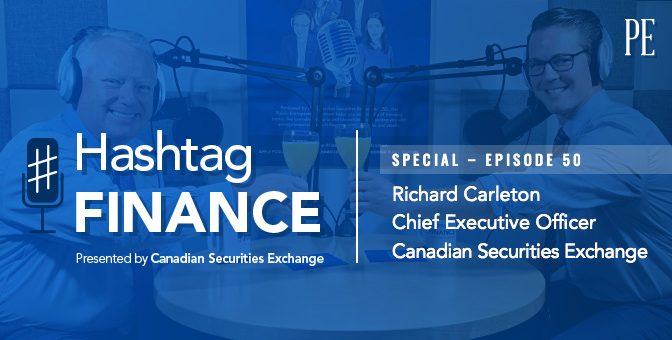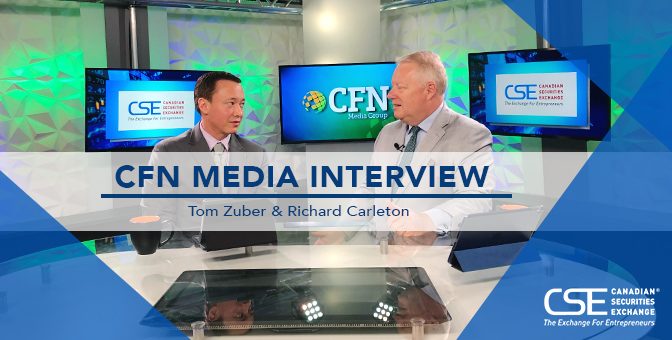First of all, given that Canada remains in varying phases of lockdown due to COVID-19, how is the CSE team doing? Is everyone healthy and adjusted to working on a different basis for the time being?
Yes, everyone is in fact healthy and team morale is excellent. Right now, we have a small number of people at the head office in First Canadian Place in downtown Toronto – one IT person and usually two members of the market operations team, sometimes augmented by our software development group. They are all driving to the office rather than taking public transit.
The building has strict rules in terms of wearing face masks in public areas and distancing in the elevators, but very few people have come back to the office. We are definitely making good use of the various video-calling applications available, so teams are getting together on a daily basis for updates, to share information, and so on. And I’m pleased that people also get together for an occasional social event via video conference. I hear there may even be some games of chance involved one night of the week.
In any event, things have worked out well, and I say that knocking on wood furiously. There was obviously a lot of pressure on the trading systems in late March as Canadian markets experienced record levels of message traffic and close to record levels of trading activity. We weathered that storm quite nicely with a distributed workforce, which is very gratifying.
I will say the fact that many of our current team members were with the exchange during the global financial crisis in 2007 and 2008 really helped us respond to the various challenges, during March in particular. We knew what to look for and what the bottlenecks in the system were likely to be, and we had our eyes out for those issues. I can remember sending an email one Sunday in March saying we were going to see the market really come off the next day and thus needed to review our circuit breaker rules and have all the notices drafted in advance. We had some extra staff in the office that day just in case. We are very happy with the way our teams and all the machines we rely on rose to that particular challenge.
How did the exchange react in March when it became clear to Canadians that special measures would need to be taken to cope with COVID-19?
We were a little ahead of the curve in some respects. Many of us were at the PDAC mining conference in Toronto, and as it became apparent that a number of PDAC attendees had contracted COVID-19, we placed ourselves into voluntary self-isolation right away. As a result, we were about a week ahead of the official lockdown orders, and that put us in good shape because we had already done most of the things we would have been required to do later in the month.
As well, we have various protocols in place that have been rehearsed over the years. These anticipate the Toronto office not being available or the Vancouver office not being available and having to distribute the workload to people working remotely. We had a pretty good idea of what needed to be done.
Now, I don’t think any of us ever anticipated that we would be working like this over the course of many months, but, as I say, we had thought through this in advance and done some rehearsals, so it was really just a case of dusting off the plans and executing them.
The head office sounds quiet for the time being, but what do you anticipate in terms of gradually returning to “normal” or what you envision as your new normal? And what does Richard Carleton’s typical day look like?
People ask me what reopening is going to look like for us, and my answer is that we have been functioning throughout. We have been conducting business across all lines, whether it is trading services, market information, or listings. And as I mentioned, we are quite pleased with how everything has worked. Activity, particularly in corporate finance and listings, has been robust over the past couple of months, to say the least.
With things going as well as they have been, we are in no rush to have everyone return to the offices in Toronto and Vancouver. One of the issues is physical capacity in elevators, because we could undermine our productivity lining up to go upstairs and downstairs multiple times a day. Another issue is that many of our employees use public transit to get to the office, and people are uncomfortable with regular use of public transit right now. I don’t see that opinion changing until we get a better handle on infection rates, particularly in Toronto.
One other thing to consider is that some on our team have school-age children, and it’s not clear at this point what is going to happen in Ontario or British Columbia. Will school be back five days per week? Will it be a partial return? Will significant levels of homeschooling continue? Those are all things we have to be sensitive to when thinking about any return. My sense is we are going to be at less than full capacity, certainly at First Canadian Place, for the foreseeable future.
As for my day, it is kind of interesting. In normal times, I have a lengthy commute morning and night, and that has been replaced by walking to my basement to begin the workday. I have always been an early riser, and there has been no change there. I began using that extra time in March to give people a heads-up on what to expect each day. I scan the global financial press and other information sources every morning and send a note to all staff with thoughts on what we should expect and try to have that out no later than 7:30 in the morning. After that, my workday starts.

How has this environment influenced activity at the exchange, in terms of trading, new issues, the new-issuer pipeline? Are there pluses and minuses?
We saw a tremendous amount of trading activity in March as stocks collapsed and then returned in record fashion in all markets. But financing was slow in April as a result of the uncertainty we saw in late March. There was a strong rebound across all of our business lines in late April and into May, and that has continued right through into July. We are trading on sunny July days at levels that I would have said you were crazy if you told me five years ago that these were the sorts of numbers we were going to be doing.
It may be a function of retail investors playing such a large role in our market. Even if people are getting out a bit more than before, they still have time on their hands, so they’re doing a lot of trading from home. That’s clear from the numbers we see on the turnover front.
On the corporate finance side, our numbers on a year-over-year basis are down a bit in terms of capital raised, and that really was a function of April being quiet. But there have been more deals. So, a little less money, but probably 25% or so more individual financing transactions being completed.
I think we can explain that in a few ways. One is that we obviously don’t have a long list of cannabis issuers raising large amounts of money, as was the case at this time last year. That having been said, I will point out that we are starting to see some of the big multistate operators listed on the CSE raise meaningful amounts of capital again, which is a good sign for the sector.
We are also seeing a lot of interest in precious metals exploration, energy metals, rare earths, and other commodities. Generally speaking, the amounts raised to fund exploration projects are smaller than those that the big cannabis issuers were raising in recent years.
I think through the end of May, CSE issuers had closed nearly 450 transactions, which is more than three per day. New listings have also remained healthy, with April being the exception. And the applications pipeline suggests a continued strong flow of new issues over the next few months. I am a little surprised by that, but we obviously are all very pleased.
Let’s talk about some of the numbers from the first half of 2020 as a whole, and then how the first quarter and the second quarter differed.
Trading volume in the second quarter was considerably higher than in the first quarter due to the market volatility. The corporate finance numbers are a bit skewed, because one of our US cannabis issuers raised US$300 million in January, so the total dollar amount favours the first quarter over the second. But since activity in general started to rebound in late April, the number of financings coming to market has really increased. I’d also say there has been a shift in capital formation from the cannabis space to the mining space, and good interest in technology as well.
I’ll point out again that these are not companies that will raise tens or hundreds of millions of dollars at a time. So, more money raised in the first quarter and really positive in terms of the number of transactions being completed throughout the first half.
One other important number I would highlight is IPOs completed in the first half. There were 17 IPOs across all Canadian exchanges, if you disregard CPCs and SPACs, and 15 of those took place on the CSE. Considering the slow pace of IPOs just a few years ago, this is great to see for Canadian financial markets. The majority of IPOs on the CSE were in the mining sector, which I think is also worth noting.
The creation of a senior tier at the CSE is a topic of importance to both existing and potential issuers. What can you tell us about progress toward establishing the new tier?
We are deep in discussion with the corporate finance staff from the BC and Ontario securities commissions. I am very pleased with the progress we have made to date, and we will look to publish proposed rules for the junior and senior tiers as soon as we have come to an understanding on all of the issues with the securities commissions. When we reach that stage, there will be an opportunity for members of the public, corporate finance professionals, and our issuers to provide specific comments on the proposed rule changes. Things are going well, though, and it is pretty much the biggest undertaking we have going over the course of the summer.
Can you update us on the clearing and settlement platform? That is also a huge undertaking, and it involves a wide range of parties in the financial community who do business with the exchange or for whom the exchange facilitates business.
We have identified partners who will be extremely important in executing this project as we move into the production phase. We are doing an awful lot of work on it, and this summer will be spent getting to the point where we can engage groups from the dealer and vendor communities to work with us on testing.
Let’s discuss changes in the approach to marketing, as the CSE team spent a lot of time on the road right up until the end of February. That is not the case now, nor for the foreseeable future. What new ideas emerged to help the team adapt and ensure marketing activities remained effective?
We have been very active on a variety of social media channels and have transitioned sales and marketing efforts away from individual meetings and conferences for the time being. We have replaced that with active use of Instagram broadcasts, our YouTube channel, and other online media to engage with our audience. We are at the point where we can begin to assess what is working and what is not.
The nice thing is that these activities are considerably less expensive than the kind of work we were doing before. We can fail fast on them, without significant financial impact to the organization, and direct resources to the channels where we are getting engagement. We have been doing a lot of interviews with thought leaders in emerging areas. One of the popular ones recently has been the psychedelics space.
We have also collaborated with MNP and the Aird & Berlis law firm on a series of webinars on various subjects. We’ve done psychedelics and technology, and we’ll have a cannabis update in August. We have been able to engage several hundred people at a time and are starting to see increasing numbers of subscribers to our YouTube channel and people following live on Instagram. Barrington, Phil, Grace, James Anil, Anna – everyone is getting lots of face time on these channels and engaging with different parts of our constituency.
It has been interesting and a great learning experience, and we are definitely figuring out how to better target our efforts. And it is considerably less expensive than doing things the old-fashioned way, which has been good for our bottom line.
The leadership team at a securities exchange has a somewhat unique perspective from which to observe the national business community. What are your thoughts on diversity among small-cap public companies at the management and board levels?
There is no shortage of data to suggest that management, boards of directors, and senior advisors of Canadian small-cap companies tend to be largely male and largely white, and therefore don’t reflect society more broadly. I look at the Canadian Securities Exchange, and our board and senior management team tend to fall into that category.
I am pleased that our workforce is, generally speaking, representative of the populations of Toronto and Vancouver, so it’s very diverse. And one of our challenges is identifying how we get to a greater degree of diversity in our management ranks, and on our board as well. We need to act in ways that see the Canadian Securities Exchange, in a short period of time, represent the demographic of Canada generally, and our home markets in Toronto and Vancouver more specifically.
Is there a specific role for junior capital markets to play in helping the world overcome the COVID-19 crisis?
That’s a bit of a chestnut. Small business is the engine of economic growth and employment growth and innovation in an economy. But they get to be chestnuts because there is a kernel of truth in them. We certainly see companies looking for different applications, whether they are looking for vaccines, or to lessen the severity of COVID-19 symptoms, or to anticipate outbreaks in areas at risk using combinations of data and artificial intelligence.
There are obviously many things the small-cap community is working toward in response to the epidemic. You never know where breakthroughs are going to come from. But there clearly is no shortage of entrepreneurial energy, and significant resources have been made available to help companies try to solve some of these problems.







